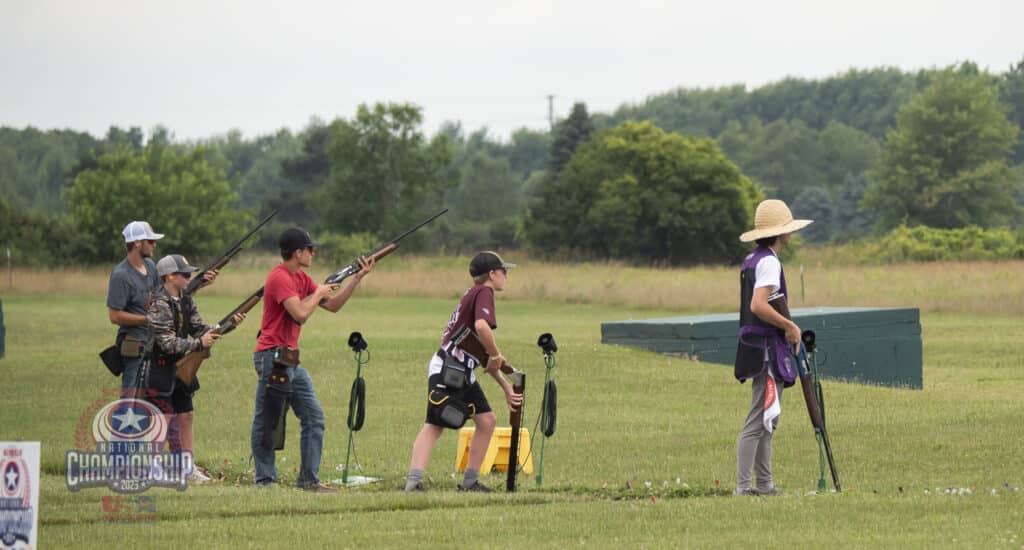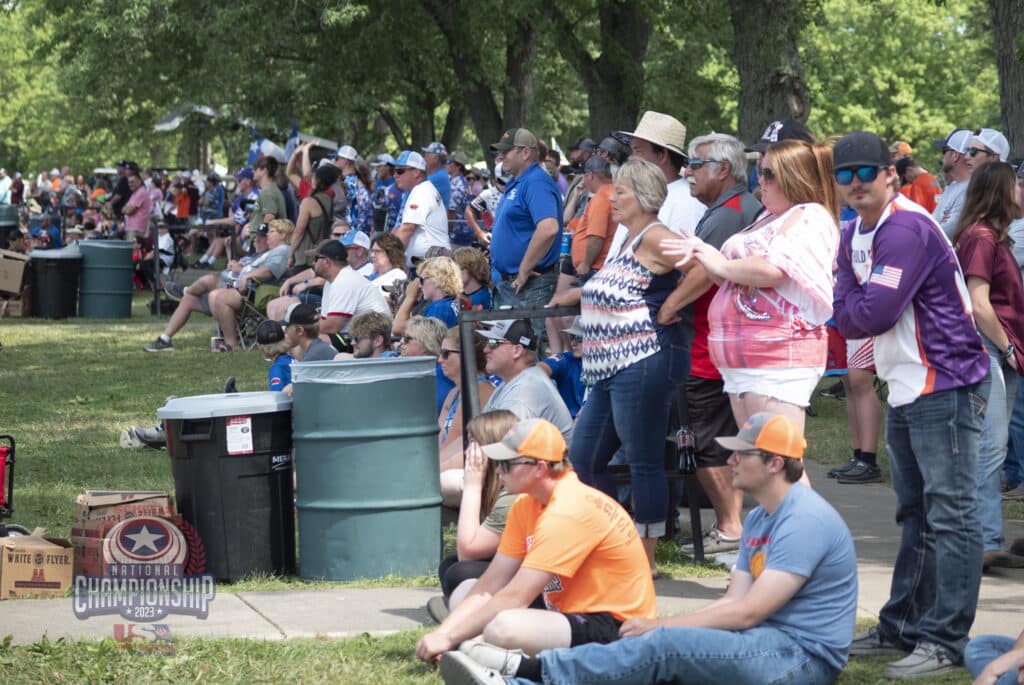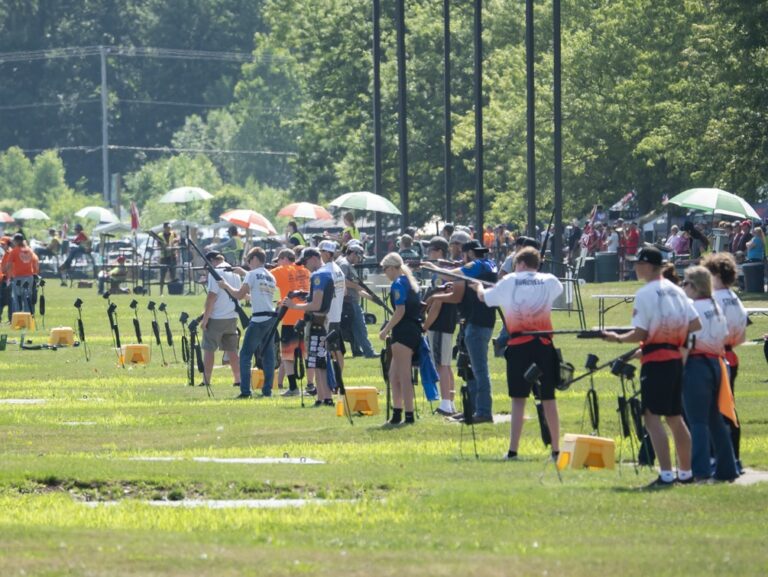Cheering crowds, proud parents, and young, driven high-school athletes. You are likely to associate all this with Friday night football, weekend basketball tournaments, or day-long track and field meets. But one sport that may not come to mind is among America’s fastest-growing extracurricular activities—a sport that’s long-established yet has expanded rapidly in recent years.
High schoolers are falling in love with competitive clay-target shooting.
“In the beginning of my shooting journey I became hooked because it felt like the first thing I was pretty good at and I felt like I could excel at,” Brendan Birch, a recent high school graduate who competed for the Frederick Stars and Stripes, told The Reload. “What continued to grow my connection to this sport is the friendships and advice received from everyone around me.”
The Stars and Stripes are a clay target club team based in Frederick County who competes statewide in the Maryland Clay Target High School League and nationally in the USA High School Clay Target League. Both leagues are divisions of a broader organization, the USA Clay Target League or USACTL.
The first division of the USACTL began in 2001 in Minnesota, with three high-school teams and 30 athletes. After working to gain traction for a few years, the league hit a rapid growth rate in the early 2010s, becoming more popular year over year statewide, and by 2013 there were over 3,500 participants and 114 teams. Since then, participation has expanded nationwide and now includes college teams. In 2022, the league contained more than 1,500 teams and nearly 45,000 athletes, according to its annual report.
The league also reported a 95 percent athlete-retention rate, indicating how much they enjoy the sport and programs. So, what has gotten all of these young athletes into the sport and kept them engaged?
“That ability for athletes to represent their schools and be a part of their larger school community is very attractive. There’s a number of students that simply aren’t part of other activities in school, they’re not interested in other activities in school,” Drew Tri, who works in marketing for USACTL, told The Reload. “We’re giving schools the opportunity to provide participation activities to [those] students.”
Clay-target shooting has been a popular competition for many years, and each league has its own slight variation. USACTL’s competition includes two rounds of 25 targets per athlete, with five athletes each at their own shooting station. In a round, targets are launched for athletes to fire on from their respective stations. After five shots at a station, the athletes rotate to a new station until each team member has shot 25 targets.

Schools and families are perennially on the lookout for the right youth extracurriculars. Options like football and band dominate the public imagination, but there are countless students out there who aren’t interested in the more popular sports and competitions, yet are searching for a team to be a part of. For those who happened to grow up around guns or hunting, clay shooting is often the perfect opportunity.
Birch’s father, Billy, was a cop for 25 years and has experience as a firearm instructor. He used to compete in pistol-shooting competitions, so Birch’s introduction to the sport was seamless from a young age.
“From the moment he was able to hold a Nerf gun, I was teaching him firearm safety and handling skills,” he told The Reload.
Of course, not every child has a parent with that kind of firearm experience. To appeal to newcomers as well, leaders in clay-target shooting have put work into making the sport a point of entry that’s safe, exciting, and welcoming. That might sound hard, but Stars and Stripes founder and coach Chuck Farmer told The Reload that young people are naturally curious about firearms, and a shooting team provides a safe environment in which to explore.
“What I’ve found is that every kid is interested. Even if it’s from a distance, they have a curiosity about it,” Farmer said. “And I would much rather have a kid know, go through the safety, understand how to use a firearm rather than experiment at a friend’s house.”

While the growth of target shooting has been steady for over a decade, three years ago a global emergency inadvertently created an opportunity for the sport. When schools and communities shut down most sports at the onset of the COVID-19 pandemic, clay shooting had an opening as an inherently outbreak-resistant sport—it is outdoors, non-contact, and can even be done alone. In fact, Farmer formed the Stars and Stripes squad in the spring of 2020, when there were severe limitations on what people could do.
“Trap shooting is one of the sports that actually has COVID compliance already built in without even knowing,” Farmer said. “Where some other programs were putting restrictions that were prohibitive, the High School Clay Target League was ideal. They had an online program where the kids could shoot at their local club.”
For many, it was the obvious alternative to sitting at home waiting for other sports to return.
“I started shooting during COVID for fun because all the other sports were cut out,” Brendan Birch said.
He’s also witnessed the team’s growth firsthand.
“When we did the Pine Valley shoot last year we kind of struggled to get a squad together. This year, we had probably a dozen people that were gonna be coming. We probably had one and a half squads total for that,” he said. “Then I know for the AIM Grand Championships this year, I think they have two squads that they’re taking out.”
And now that the pandemic has subsided, many have found it’s a sport worth sticking with. For those involved, two aspects vital to the sport’s growth consistently come up: the supportive environment and safety. Tri described the atmosphere of USACTL competitions with pride.
“This event is a family event, that families go together and cheer on their athletes and cheer on their teams and bring their mascots and their banners and their school spirit, and there’s just nothing else like that,” Tri said. “One of the most important things that people don’t realize is how this brings schools and communities together.”

Billy Birch echoed that sentiment.
“I can tell you, it’s one of the greatest communities,” he said. “Everybody was just so welcoming and nice. All the parents and coaches are awesome and supportive.”
He said the atmosphere at USACTL or Amateur Trapshooting Association (ATA) events is distinct from other sporting events. He said the nature of the community and the sport itself helps foster a particularly constructive atmosphere.
“I used to be a swimmer, I was a swimmer for seven years. You know, like 4:30 a.m. practices three times a week, six times a week practicing, stuff like that,” Birch said. “I’ve actually pointed it out to multiple people in the past that trapshooting, even though it’s technically an individual sport, I’m still competing against people on my team for the overall averages in the Maryland Clay Target High School League. But people are always willing to give you advice, and you didn’t get that really in swimming because everything was so individual. You’re fighting for that extra millisecond over your competitor, you don’t want to give them an advantage. If you talk to anybody at any ATA shoot or non-registered shoot, they’re always willing to give you advice. And it’s way different than what I’ve ever seen in any other individual sport.”
The league’s national championship took place last month in Mason, Michigan, with 3,000 athletes testing their marksmanship against each other. Footage of the event backs up Tri and Birch’s testimonials. Parents and coaches filled the grass behind athletes, cheering them on at each stage. Tents were lined up in tight quarters as families try to stay out of the blazing sun but everyone is engaged in the action unfolding before them. It’s a sight straight out of a high school basketball or football game.
Tri maintained that safety is paramount to the USACTL’s success. The league requires participants to complete a firearm-safety course to compete and educates the athletes before they can practice. It also requires a minimum of one coach per 10 team members to ensure proper supervision and training.
“We have our own data, and that data is really simple. We have never had an accident or injury in the years that the league or its predecessors have been in existence. That’s with over 150,000 athletes participating in the program over the years,” Tri said. “Zero is zero.”
Not everyone is aware of or appreciates the safety record of the sport. Some can be put off by the involvement of firearms, though Brendan Birch has found most come around once they have a conversation with him.
“You do get the odd looks from certain people that don’t quite understand it, which is unfortunate,” Birch said. “And I feel like that’s kind of evolving as people realize how safe the sport actually is. But with all my friends—and it’s probably partly due to the kind of small-town environment—a lot of them are really open to it and think it’s cool, especially when I explained to them All-American points for the ATA and that I’m 22nd right now for juniors.”
But things are moving in the other direction in some parts of the country as the sport’s safety record has not shielded it from conflict with some lawmakers. California Governor Gavin Newsom (D.) upended youth shooting sports in the state last summer with a law banning firearms-related advertising “that could be appealing to minors.” Illinois Governor J.B. Pritzker (D.) signed a similar law restricting firearms advertisements to minors this month. California lawmakers backed down on their version and Newsom signed a clarifying law exempting youth sports organizations later that year. That reversal was a relief to the USACTL’s California division, and Tri said the exemption built into the Illinois law should cover the league’s activities.
Still, youth shooting leagues could face further fights with lawmakers if the idea of trying to restrict guns designed for young shooters or their advertising catches on in other states.
Birch said one problem is the lack of a clear path from shooting leagues based around school teams to post-grad opportunities to continue in the sport. He said that hollows out the sport and prevents it from gaining more popularity.
“Attendance has grown and it needs to because if you go to any ATA shoot you’ll just see a huge age gap,” he said. “The gap is because the high school clay target league ends when you get out of high school and a shooter might go into college, but then you don’t have anybody transitioning into the ATA. So, the sport doesn’t gain members over time. Then you get people coming back into it when they retire. It really needs to be kind of a seamless transition for people. That education structure needs to be there.”
Cost is another significant barrier to the sport’s future growth. Guns, ammunition, targets, and gun club memberships are just the beginning of the expenses families must consider when deciding if their kid should take get involved. Cost is a growing problem for all youth sports around the country and competitive shooting may be one of the most expensive.
Tri estimated that a season would cost an individual between $300 and $325, taking into account targets, ammunition, and registration fees. That is, however, not including a gun, team jerseys, and more. Birch has likely spent much more as he’s begun to pursue the sport more seriously.
“First time I touched a shotgun was three years ago,” he said. “I got my ATA membership in July of 2021. And I shot 200 targets that year. Last year, I shot about 10,000 targets. This year, I’m on track to shoot about 15,000.
But that practice has paid off. Birch has traveled up and down the East Coast to compete and returned home with trophies in hand.
“I took home 18 trophies from the 2022 AIM Grand,” he said. “This year I have gone to the southern grand, Georgia, Maryland, Delaware, New Jersey, and Pennsylvania.”
Birch won four of the five junior championship titles at the Pennsylvania event and he has no plans of letting up anytime soon. He and his teammates show the new generation of competitive shooters has set the foundation for the future of the sport. And other people are starting to take notice.
“When they’re so used to thinking of football stats and basketball stats and baseball stats, when you tell them you’re 22nd in the nation, their eyes open a little bit and they’re like, ‘Whoa, that’s kind of crazy,'” Birch said.




